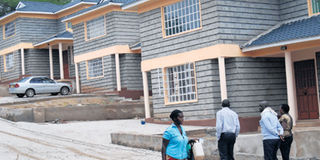Rents soar as more Kenyans fail to afford mortgages, says report

Houses under development in Rongai. So grim are the statistics that The Mortgage Company estimates that only 50 per cent of urban residents can afford a Sh700,000 house. PHOTO | FILE
What you need to know:
- Caroline Kariuki, the managing director of The Mortgage Company, says that despite some minor adjustments and short-term interest rate discounts, Standard Chartered Bank remained the lowest cost lender at 13.9 per cent.
- Until then, and with cash buyers continuing to drive the market, some further asking price rises are likely in 2014, based on the reduced flow of new buildings caused by the high level of finance costs for developers.
The latest Hass Consult report shows that half of all urban Kenyans cannot afford mortgage loan repayments for a house worth Sh700,000 and that only one per cent of urban Kenyans can currently afford the mortgage repayments for a house priced at Sh5.7 million.
Only a further four per cent can afford a house worth Sh3.9 million.
Early this year, Deputy President William Ruto called for an enabling environment to allow Kenya to achieve one million mortgages, up from today’s 20,000, and for a single-digit interest rate, but this call has remained unheeded.
Caroline Kariuki, the managing director of The Mortgage Company, says that despite some minor adjustments and short-term interest rate discounts, Standard Chartered Bank remained the lowest cost lender at 13.9 per cent.
“The most expensive mortgages are offered by Consolidated Bank at 19 per cent, while Chase Bank is the only bank to negotiate counter rates with individual clients in a range between 16.5 per cent and 19 per cent,” Ms Kariuki says.
“With the mainstream lenders hanging on tenaciously to such high margins on their lending, the delayed take-off in Kenya’s mortgage market is distorting the country’s housing range, discouraging private developers, and locking out most Kenyans from home ownership. In the absence of a more constructive approach from the commercial lenders, mortgage take-up now depends on government intervention, either through supporting mortgage-backed securities to stimulate the secondary mortgage market or through the creation of housing funds and even mortgage subsidies,” she adds.
Ms Sakina Hassanali, head of marketing at HassConsult, says the market continues to be handicapped by the lack of access to mortgages for mid and lower level buyers, where demand is greatest.
The bottleneck in housing finance also continues to push rents up as professional Kenyans live in rented accommodation, with the rental of choice being semi-detached town houses.
Asking rents for semi-detached houses rose 2.3 per cent in the first quarter of 2014, compared with prices from October to December 2013, and were 18.1 per cent higher compared to the same period last year. The rent increases for detached houses were much more subdued, at 8.7 per cent in March 2013, while apartment rents rose by 4.4 per cent across the year.
“With the finance blockage also impacting landlords in acquiring new properties and the rental yields on properties still at less than mortgage interest rates, the race is now on to get rents up to a level where landlords can cover finance costs and not end up making losses,” says Ms Hassanali.
Until then, and with cash buyers continuing to drive the market, some further asking price rises are likely in 2014, based on the reduced flow of new buildings caused by the high level of finance costs for developers.
However, many developers have now found alternative means of financing, either by raising money outside Kenya or through taking equity stakes in projects.
“The outlook is for some marginal improvement in the rate of new buildings from this year, but a market that will continue to be substantially oriented to cash buyers — meaning the very wealthy — until housing finance becomes a policy priority,” says Ms Hassanali.
“Demand for housing is highest at the lowest end of the market, but the financing options are almost non-existent, rendering the private sector property market a high-end affair.”





